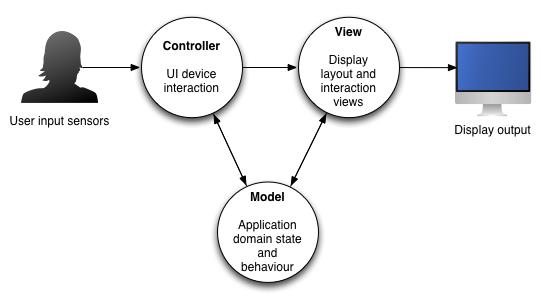In part 1 of the MVC story, I examined “Thing-Model-View-Editor”, a pattern[*] extracted by Trygve Reenskaug’s work in Smalltalk-76. By the time Smalltalk-80’s hot air balloon set sail from the ivory tower, there was already a structure called Model-View-Controller.
Part Two: MVC and Smalltalk
[*] Bear in mind that I’m retroactively applying the word “pattern” here. Design Patterns as a thing, modelled on the book modelled on the other book, do not belong in this story for another 15 years or so.
This story will be told through the lens of a single overview article: A Description of the Model-View-Controller User Interface Paradigm in the Smalltalk-80 System by Krasner and Pope is the first. The authors give their affiliation as “ParcPlace Systems, Inc.”, a company that built tools on top of Smalltalk. It was founded by ACM president Adele Goldberg, who originally developed Smalltalk along with Alan Kay and others.
Krasner and pope say that MVC is an application of a particular three-way factoring of a software problem into objects:
separating (1) the parts that represent the model of the underlying application domain from (2) the way the model is presented to the user and from (3) the way the user interacts with it.
They go on to say that it was observed that most Smalltalk-76 applications offer the same interaction—images, buttons, text and menus—and that the goal of the MVC factoring in Smalltalk-80 is to handle those interactions in a common way across all applications.
The model and the view hold the same positions that they did in TVME: the models represent the thing in a computerey way, and the views represent the model on the bitmap display. “Controllers are used to send messages to the model, and provide the interface between the model with its associated views and the interactive user interface devices (e.g., keyboard, mouse). Each view may be thought of as being closely associated with a controller, each having exactly one model, but a model may have many view/controller pairs.” The controller is to MVC as the editor was to TVME.
So, the controller is the thing that senses and responds to UI events. Because you probably only intend for one thing to happen when you press a key or click a mouse button, only one controller is active at a time. That controller can interpret your command as a requirement to edit or query the model, or to display or change a particular view.
The views can also edit or query the model. So, there’s a need for the model to let the controller know when it was changed by a view, and the views should know when the model was changed by the controller. Enter dependents!
Dependents represent a realisation of what would later be known as the Observer pattern. The model can keep track of a collection of the objects that care about its changes. When it changes, it sends a changed or changed: message to its dependents.
Smalltalk-80 supplies bundled abstract classes for each of Model, View and Controller. The article goes into each of these classes and some of the subclasses that have already been created, showing how inspectors, editors and debuggers in Smalltalk-80 are all built from this factored collection of objects. It also details complete applications, including the FinancialHistory tutorial from “Smalltalk-80: the Language and its Implementation” by Goldberg and Robson.
Looking in the blue book, as it’s known, none of the terms MVC, model, view, nor controller appear in its index. The classes Model, View and Controller are not in the example class index, and the dependents, changed and changed: methods are not in its implementation index. The FinancialHistory object is described throughout the book, but is a subclass of Object and does not participate in any factoring that’s similar to MVC.
It’s probable that this reference is a mistake, and that Krasner and Pope intended to refer to the red book “Smalltalk-80: the Interactive Programming Environment” by Goldberg. This does indeed describe MVC, but only in relationship to the “MVC Inspector”. However, the description of the inspector shows that the pattern was common enough to motivate the construction of bespoke UI:
Many objects in the Smalltalk-80 system are closely related to one another. In particular, the user interface of the system is implemented using subclasses of two classes, class
Viewand classController. AViewrepresents ways of presenting information on the screen; aControllerrepresents ways in which the user interacts with a screen view. AnyViewis related to aControllerand to another object, the object whose information is accessed in theView. This other object is referred to as a “model.” Whenever you inspect aView, you typically want to inspect its related model orController. There is a special inspector in the system for inspecting the two main objects related to aView, as well as theView, whenever aViewis sent the messageinspect.
Having mentioned the red and blue books, it seems appropriate to introduce the green book, “Smalltalk-80: Bits of History, Words of Advice” edited by Glenn Krasner (the first author of the paper we started at). There is no MVC in the green book, but the three books[*] together are a fascinating snapshot of this time in our industry.
[*] There is a purple book too, but it’s just half of the blue book repackaged.
So Smalltalk-80 MVC is a formalisation of the abstract collaboration between objects documented as Thing-Model-View-Editor. It is an idiom named after the developer tool that was designed to take advantage of the common relationships between these objects. At some point after its initial documentation, authors (Krasner and Pope along with others) decided that this was not merely a factoring, but a “User Interface Paradigm”.



